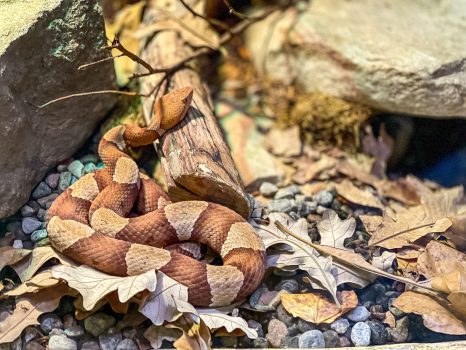Copperhead
Common Name: Copperhead
Scientific Name: Agkistrodon contortrix
Names: N/A
Locations: Whitby


Diet
Copperheads are venomous snakes and primarily feed on a diet consisting of small rodents, frogs, lizards, and occasionally birds and insects.
Average lifespan
In the wild, Copperheads typically live around 10 to 15 years, though their lifespan may vary depending on factors such as habitat quality and predation.
Size
Copperheads are relatively small to medium-sized venomous snakes, with adults reaching lengths of up to 61 to 91 centimeters (2 to 3 feet) on average.
Weight
Adult Copperheads can weigh anywhere from 200 to 500 grams (7 to 18 ounces).
About
Copperheads are pit vipers found primarily in North America, ranging from the southeastern United States up into parts of Canada. They inhabit a variety of environments including forests, rocky hillsides, and wetlands. Copperheads are venomous, but their bites are rarely fatal to humans.
Size and behavior
Copperheads are characterized by their distinctive copper-colored heads, which give them their common name. They have a stout body and can be identified by the hourglass-shaped patterns along their bodies. Copperheads are typically nocturnal or crepuscular, meaning they are most active during dawn and dusk. They are ambush predators, lying in wait for prey to pass by before striking.
Diet and nutrition
Copperheads primarily prey on small mammals such as mice and voles. They also eat amphibians, reptiles, and insects. Once they have bitten their prey, they inject venom to immobilize it before consuming it whole. Copperheads play an important role in controlling rodent populations.
Conservation status
The conservation status of Copperheads is not of significant concern as they are widespread and relatively adaptable. However, habitat destruction and fragmentation, as well as persecution by humans due to their venomous nature, can pose threats to local populations. Overall, their populations are stable, but localized declines may occur due to habitat loss.
Fun fact
A fascinating fact about Copperheads is that they exhibit a behavior called “caudal luring.” When hunting for prey, they may wiggle their yellow-tipped tails, mimicking the appearance of a worm or a caterpillar. This movement attracts small mammals or amphibians, enticing them to come closer, unaware that they are actually approaching a deadly predator. This cunning behavior demonstrates the Copperhead’s resourcefulness in capturing prey.
Call or visit your local Reptilia Facility to learn how you can adopt one of these amazing reptiles.








